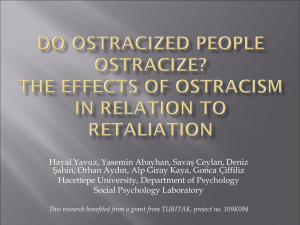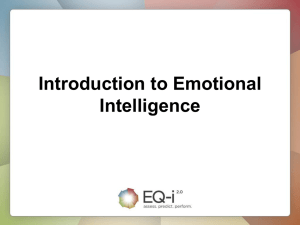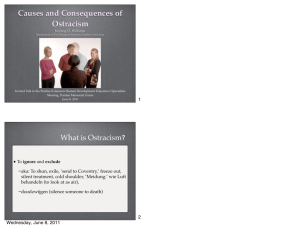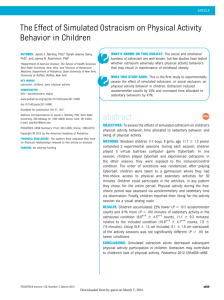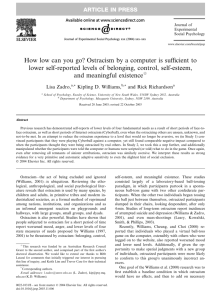The Relationship between Trait Emotional Intelligence and
advertisement
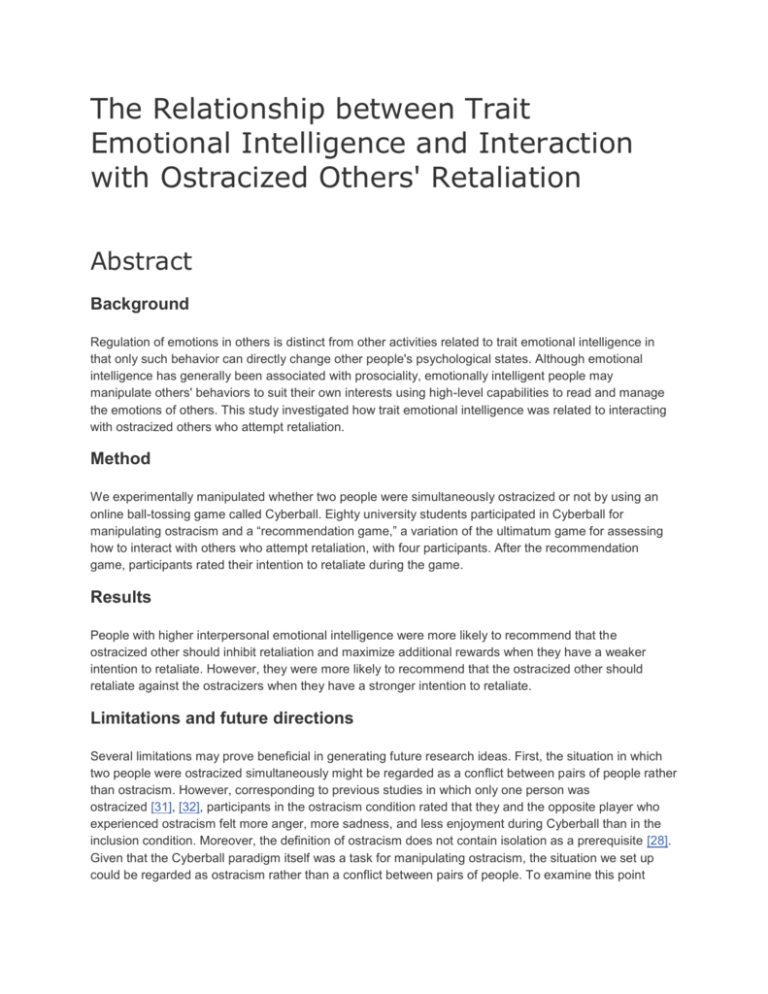
The Relationship between Trait Emotional Intelligence and Interaction with Ostracized Others' Retaliation Abstract Background Regulation of emotions in others is distinct from other activities related to trait emotional intelligence in that only such behavior can directly change other people's psychological states. Although emotional intelligence has generally been associated with prosociality, emotionally intelligent people may manipulate others' behaviors to suit their own interests using high-level capabilities to read and manage the emotions of others. This study investigated how trait emotional intelligence was related to interacting with ostracized others who attempt retaliation. Method We experimentally manipulated whether two people were simultaneously ostracized or not by using an online ball-tossing game called Cyberball. Eighty university students participated in Cyberball for manipulating ostracism and a “recommendation game,” a variation of the ultimatum game for assessing how to interact with others who attempt retaliation, with four participants. After the recommendation game, participants rated their intention to retaliate during the game. Results People with higher interpersonal emotional intelligence were more likely to recommend that the ostracized other should inhibit retaliation and maximize additional rewards when they have a weaker intention to retaliate. However, they were more likely to recommend that the ostracized other should retaliate against the ostracizers when they have a stronger intention to retaliate. Limitations and future directions Several limitations may prove beneficial in generating future research ideas. First, the situation in which two people were ostracized simultaneously might be regarded as a conflict between pairs of people rather than ostracism. However, corresponding to previous studies in which only one person was ostracized [31], [32], participants in the ostracism condition rated that they and the opposite player who experienced ostracism felt more anger, more sadness, and less enjoyment during Cyberball than in the inclusion condition. Moreover, the definition of ostracism does not contain isolation as a prerequisite [28]. Given that the Cyberball paradigm itself was a task for manipulating ostracism, the situation we set up could be regarded as ostracism rather than a conflict between pairs of people. To examine this point further, future research should use measures specific to ostracism such as lowering a feeling of belonging. Second, there was no significant difference between conditions in the rate of recommending “accept” to the opposite player who had chosen to reject the fair offer by the left or right player. In this situation, either recommending ostracized people to accept or to reject the offer was a valid action, because the former could maximize the ostracized others' additional reward by regulating others' anger while the latter could respect the will of the ostracized others. There was no reason to predict that people were more or less likely to recommend ostracized people to accept the offer than the included people. For this reason, we think that the rates of the “accept” recommendation did not differ between conditions. If the types of regulation of others' emotion were different from attempts to regulate retaliation such as consoling someone in sorrow or making someone laugh, people may more likely behave in such a way to ostracized others than included others. Future research could examine this possibility. Third, it remains unclear whether trait EI still predict how to interact with ostracized others who attempt retaliation over and above established constructs such as Big-Five, because we did not assess other selfconcept measures. However, given that many previous studies has demonstrated trait EI predicts a number of emotional reactions and achievements after statistically controlling for other established constructs, there is a high possibility that the relationship which this study revealed will still exist over and above other constructs. To clarify this point, future research should assess other established constructs (e.g., Big-Five) and examine whether trait EI still predict behavior for regulating others' emotions after statistically controlling these constructs. Forth, various other EI measures were used in previous studies such as Trait Emotional Intelligence Questionnaire (TEIQue). Future research should investigate whether the results of this study could be replicated by using other EI measures. Conclusion This is the first laboratory study to empirically reveal that those who have high interpersonal EI attempt to regulate others' emotions based on their own goals. People with higher interpersonal EI were more likely to recommend that the ostracized other should accept a fair offer from the ostracizers when the emotionally intelligent people had a lower intention to retaliate. However, they were more likely to recommend that the ostracized other should reject the offer when the emotionally intelligent people had a higher intention to retaliate. These results suggest that researchers should consider trait EI a personality trait that is not necessarily associated with prosociality, contrary to the general view. Trait EI facilitates interpersonal behaviors for achieving goals. This study presents an important step toward deepening our understanding of trait EI's social functions. First, Define the key terms below (Also add any additional terms you would like defined) Emotional Intelligence (EI) Interpersonal Inclusion Prosocial Ostracized Constructs Figure 1. Interactive effect of interpersonal emotional intelligence and intention to retaliate. show more The graph illustrates the result of simple slopes for the association between interpersonal emotional intelligence and participants' recommendation to the ostracized person depending on intention to retaliate. doi:10.1371/journal.pone.0077579.g001 Table 1. Means and standard deviations of emotions felt during Cyberball . Questions: 1. How did psychologists construct their study? What did they seek to measure and how did they go about measuring it? 2. What were their findings? What is your reaction to their research and findings?? What are some questions/conflicts you have regarding their study? What are some of the limitations they mention regarding the study? 3. What is the difference between prosocial behavior and emotional intelligence? Do you think emotional intelligence and empathy are the same thing? 4. What are the educational or cultural implications for this study? What should educators and parents do to ensure prosocial behaviors?

